|
|
History | Climate |
Government
|
Economy | Arts and Culture
| Architecture |
Fashion, Shopping and-
Entertainment |
Sports | Education |
Media |
Infrastructure |
Health
and Medicine | Popular Culture
| Crime
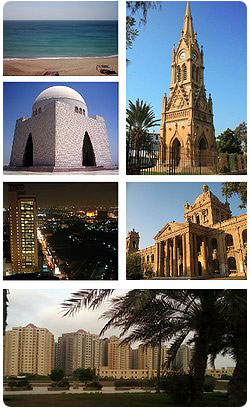 Karachi
(Urdu: کراچی, Sindhi: ڪراچي) is the largest city, main seaport and the
financial capital of Pakistan, and the capital of the province of Sindh.
With a city population of 15.5 million, Karachi is one of the world's
largest cities,13th largest urban agglomeration and the 20th largest
metropolitan area in the world. It is Pakistan's premier centre of banking,
industry, and trade. Karachi is home to Pakistan's largest corporations,
including those that are involved in textiles, shipping, automotive
industry, entertainment, the arts, fashion, advertising, publishing,
software development and medical research. The city is a major hub of higher
education in South Asia and the wider Islamic world. Karachi is ranked as a
Beta world city. Karachi
(Urdu: کراچی, Sindhi: ڪراچي) is the largest city, main seaport and the
financial capital of Pakistan, and the capital of the province of Sindh.
With a city population of 15.5 million, Karachi is one of the world's
largest cities,13th largest urban agglomeration and the 20th largest
metropolitan area in the world. It is Pakistan's premier centre of banking,
industry, and trade. Karachi is home to Pakistan's largest corporations,
including those that are involved in textiles, shipping, automotive
industry, entertainment, the arts, fashion, advertising, publishing,
software development and medical research. The city is a major hub of higher
education in South Asia and the wider Islamic world. Karachi is ranked as a
Beta world city.
Karachi enjoys its prominent position because of its geographical location
on a bay, making it the financial capital of the country. It is one of the
fastest growing cities in the world. It was the original capital of Pakistan
until the construction of Islamabad and is the location of the Port of
Karachi and Port Bin Qasim , one of the region's largest and busiest ports.
After the partition of India and the independence of Pakistan, the city's
population increased dramatically when hundreds of thousands of migrants
from India, East Pakistan (later Bangladesh) and other parts of South Asia
came to settle in the city.
Karachi city is spread over 3,530 km2 (1,360 sq mi) in area, almost five
times bigger than Singapore. It is locally known as the "City of Lights" (روشنیوں
کا شهر) and "The bride of the cities" (عروس البلاد) for its
liveliness, and the "City of the Quaid " (شهرِ قائد), having been the
birth and burial place of Quaid-e-Azam (Muhammad Ali Jinnah), the founder of
Pakistan, who made the city his home after Pakistan's independence.
Go To Top
Search Karachi
on Satellite Maps
Places of Interest
| Hotels |
Eating &
Dining | Parks &
Gardens |
Educational Institutes |
Hospitals |
Sport Centers |
Banks |
ATM |
Fuel Stations |
CNG Stations |
Police Stations |
Shopping /Trade
History
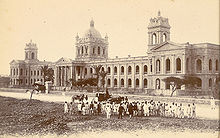 The
area of Karachi was known to the ancient Greeks by many names: Krokola, the
place where Alexander the Great camped to prepare a fleet for Babylonia
after his campaign in the Indus Valley; 'Morontobara' (probably Manora
island near Karachi harbour), from whence Alexander's admiral Nearchus set
sail; and Barbarikon, a port of the Indo-Greek Bactrian kingdom. It was
later known to the Arabs as Debal, the starting point for Muhammad bin Qasim
and his army in 712 AD. Karachi was founded as "Kolachi" by Baloch tribes
from Balochistan and Makran, who established a small fishing community in
the area.Descendants of the original community still live in the area on the
small island of Abdullah Goth, which is located near the Karachi Port. The
original name "Kolachi" survives in the name of a well-known Karachi
locality named "Mai Kolachi". The city was visited by Ottoman Admiral Seydi
Ali Reis in 1550s and mentioned in his book Mirat ul Memalik (The Mirror of
Countries), 1557 AD.The present city started life as a fishing settlement
when a Balochi fisherwoman called Mai Kolachi took up residence and started
a family. The village that later grew out of this settlement was known as
Kolachi-jo-Goth (Village of Kolachi in Sindhi). By the late 1720s, the
village was trading across the Arabian Sea with Muscat and the Persian Gulf
region. A small fort was constructed for its protection, armed with cannons
imported from Muscat. The fort had two main gateways: one facing the sea,
known as Kharra Darwaaza (Brackish Gate) (Kharadar) and the other
facing the Lyari River known as the Meet'ha Darwaaza (Sweet Gate) (Mithadar)
.The location of these gates correspond to the modern areas of Kharadar (Khārā
Dar) and Mithadar The
area of Karachi was known to the ancient Greeks by many names: Krokola, the
place where Alexander the Great camped to prepare a fleet for Babylonia
after his campaign in the Indus Valley; 'Morontobara' (probably Manora
island near Karachi harbour), from whence Alexander's admiral Nearchus set
sail; and Barbarikon, a port of the Indo-Greek Bactrian kingdom. It was
later known to the Arabs as Debal, the starting point for Muhammad bin Qasim
and his army in 712 AD. Karachi was founded as "Kolachi" by Baloch tribes
from Balochistan and Makran, who established a small fishing community in
the area.Descendants of the original community still live in the area on the
small island of Abdullah Goth, which is located near the Karachi Port. The
original name "Kolachi" survives in the name of a well-known Karachi
locality named "Mai Kolachi". The city was visited by Ottoman Admiral Seydi
Ali Reis in 1550s and mentioned in his book Mirat ul Memalik (The Mirror of
Countries), 1557 AD.The present city started life as a fishing settlement
when a Balochi fisherwoman called Mai Kolachi took up residence and started
a family. The village that later grew out of this settlement was known as
Kolachi-jo-Goth (Village of Kolachi in Sindhi). By the late 1720s, the
village was trading across the Arabian Sea with Muscat and the Persian Gulf
region. A small fort was constructed for its protection, armed with cannons
imported from Muscat. The fort had two main gateways: one facing the sea,
known as Kharra Darwaaza (Brackish Gate) (Kharadar) and the other
facing the Lyari River known as the Meet'ha Darwaaza (Sweet Gate) (Mithadar)
.The location of these gates correspond to the modern areas of Kharadar (Khārā
Dar) and Mithadar
After sending a couple of exploratory missions to the area, the British East
India Company conquered the town when HMS Wellesley anchored off Manora
island on 1 February 1839. Two days later, the little fort surrendered .The
town was later annexed to the British Indian Empire when Sindh was conquered
by Charles James Napier in Battle of Miani on 17 February 1843. On his
departure in 1847, he is said to have remarked, "Would that I could come
again to see you in your grandeur!" Karachi was made the capital of Sindh in
the 1840s. On Napier's departure, it was added along with the rest of Sindh
to the Bombay Presidency, a move that caused considerable resentment among
the native Sindhis. The British realised the importance of the city as a
military cantonment and as a port for exporting the produce of the Indus
River basin, and rapidly developed its harbour for shipping. The foundations
of a city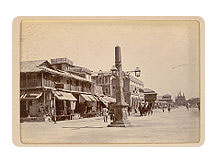 municipal government were laid down and infrastructure development was
undertaken. New businesses started opening up and the population of the town
began rising rapidly. The arrival of the troops of the Kumpany Bahadur in
1839 spawned the foundation of the new section, the military cantonment. The
cantonment formed the basis of the 'white' city, where the Indians were not
allowed free access. The 'white' town was modeled after English industrial
parent-cities, where work and residential spaces were separated, as were
residential from recreational places. Karachi was divided into two major
poles. The 'black' town in the northwest, now enlarged to accommodate the
burgeoning Indian mercantile population. In 1857, the First Indian War for
Independence broke out in South Asia and the 21st Native Infantry stationed
in Karachi declared allegiance to rebels, joining their cause on 10
September 1857. Nevertheless, the British were able to quickly reassert
control over Karachi and defeat the uprising.
municipal government were laid down and infrastructure development was
undertaken. New businesses started opening up and the population of the town
began rising rapidly. The arrival of the troops of the Kumpany Bahadur in
1839 spawned the foundation of the new section, the military cantonment. The
cantonment formed the basis of the 'white' city, where the Indians were not
allowed free access. The 'white' town was modeled after English industrial
parent-cities, where work and residential spaces were separated, as were
residential from recreational places. Karachi was divided into two major
poles. The 'black' town in the northwest, now enlarged to accommodate the
burgeoning Indian mercantile population. In 1857, the First Indian War for
Independence broke out in South Asia and the 21st Native Infantry stationed
in Karachi declared allegiance to rebels, joining their cause on 10
September 1857. Nevertheless, the British were able to quickly reassert
control over Karachi and defeat the uprising.
In 1864, the first telegraphic message was sent from India to England, when
a direct telegraph connection was laid between Karachi and London.In 1878,
the city was connected to the rest of British India by rail. Public building
projects, such as Frere Hall (1865) and the Empress Market (1890), were
undertaken. In 1876, Muhammad Ali Jinnah, the founder of Pakistan, was born
in the city, which by now had become a bustling city with mosques, churches,
courthouses, kota, paved streets and a magnificent harbour. By 1899, Karachi
had become the largest wheat exporting port in the East.The population of
the city was about 105,000 inhabitants by the end of the 19th century, with
a cosmopolitan mix of Muslims, Hindus, Zoroastrians, Christians and Jews.
There were various linguistic groups, such as Urdu speakers, Punjabis as
well as Pashtuns and Balochis. The multi-ethnic mix can be imagined from the
fact that there are more Pashtuns in Karachi than in any city of the
North-West Frontier Province. In addition to local groups, there were
immigrants of Persian, Lebanese, and European backgrounds. By the turn of
the century, the city faced street congestion, which led to Southwest Asia's
first tramway system being laid down in 1900. British colonialists embarked
on a number of public works of sanitation and transportation — such as
gravel paved streets, proper drains, street sweepers, and a network of trams
and horse-drawn trolleys. Colonial administrators set up military camps, a
European inhabited quarter, and organised marketplaces, of which the Empress
Market is most notable.
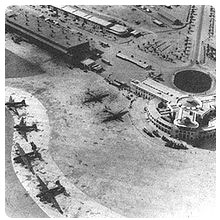 By
the time the new country of Pakistan was formed in 1947 Karachi had become a
bustling metropolis with beautiful classical and colonial European styled
buildings, lining the city’s thoroughfares. Karachi was chosen as the
capital of Pakistan, which at the time included modern day Bangladesh, a
region located more than 1,000 km (620 mi) away, and not physically
connected to Pakistan. In 1947, Karachi was the focus for settlement by
Muslim migrants from India, who drastically expanded the city's population
and transformed the demographics and economy. In 1958, the capital of
Pakistan was moved from Karachi to Rawalpindi and then in 1960, to the newly
built Islamabad. This marked the start of a long period of decline in the
city, marked by a lack of development. Karachi had both a municipal
corporation and a Karachi Divisional Council in the 1960s, which developed
plans for schools, colleges, roads, municipal gardens, and parks. The
Karachi Divisional Council had separate working committees for education,
roads, and residential societies development and planning. During the 1960s,
Karachi was seen as an economic role model around the world. Many countries
sought to emulate Pakistan's economic planning strategy and one of them,
South Korea, copied the city's second "Five-Year Plan" and World Financial
Centre in Seoul is designed and modeled after Karachi. By
the time the new country of Pakistan was formed in 1947 Karachi had become a
bustling metropolis with beautiful classical and colonial European styled
buildings, lining the city’s thoroughfares. Karachi was chosen as the
capital of Pakistan, which at the time included modern day Bangladesh, a
region located more than 1,000 km (620 mi) away, and not physically
connected to Pakistan. In 1947, Karachi was the focus for settlement by
Muslim migrants from India, who drastically expanded the city's population
and transformed the demographics and economy. In 1958, the capital of
Pakistan was moved from Karachi to Rawalpindi and then in 1960, to the newly
built Islamabad. This marked the start of a long period of decline in the
city, marked by a lack of development. Karachi had both a municipal
corporation and a Karachi Divisional Council in the 1960s, which developed
plans for schools, colleges, roads, municipal gardens, and parks. The
Karachi Divisional Council had separate working committees for education,
roads, and residential societies development and planning. During the 1960s,
Karachi was seen as an economic role model around the world. Many countries
sought to emulate Pakistan's economic planning strategy and one of them,
South Korea, copied the city's second "Five-Year Plan" and World Financial
Centre in Seoul is designed and modeled after Karachi.
The 1970s saw major labour struggles in Karachi's industrial estates, (see:
Karachi labour unrest of 1972). The 1980s and 1990s saw an influx of
refugees from the Soviet war in Afghanistan into Karachi, they were followed
in smaller numbers by refugees escaping from Iran. Political tensions
between the Muhajir and other native groups (e.g. Sindhis, Punjabis,
Pashtuns, and others), erupted and the city was wracked with political and
racial violence. The period from 1992 to 1994 is regarded as the bloodiest
period in the history of the city, when the Army commenced its Operation
Clean-up against the Muttahida Qaumi Movement. Most of these tensions have
now simmered down. Today, Karachi continues to be an important financial and
industrial centre and handles most of the overseas trade of Pakistan and the
other Central Asian countries. It accounts for a lion's share of the GDP of
Pakistan,and a large proportion of the country's white collar workers
Find more about
History of Pakistan
Go To Top
Climate
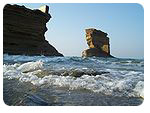 Located
on the coast, Karachi tends to have a relatively mild, arid climate with low
average precipitation levels (approximately 250 mm per annum), the bulk of
which occurs during the July-August monsoon season. Winters are mild and the
summers are hot; the proximity to the sea maintains humidity levels at a
near-constant high and cool sea breezes relieve the heat of the summer
months. Because of high temperatures during the summer (ranging from 30 to
44 degrees Celsius from April to August), the winter months (November to
February) are generally considered the best times to visit Karachi. December
and January have pleasant and cloudy weather. Located
on the coast, Karachi tends to have a relatively mild, arid climate with low
average precipitation levels (approximately 250 mm per annum), the bulk of
which occurs during the July-August monsoon season. Winters are mild and the
summers are hot; the proximity to the sea maintains humidity levels at a
near-constant high and cool sea breezes relieve the heat of the summer
months. Because of high temperatures during the summer (ranging from 30 to
44 degrees Celsius from April to August), the winter months (November to
February) are generally considered the best times to visit Karachi. December
and January have pleasant and cloudy weather.
Evening scene on Clifton beach.In 2003, 2006, 2007 and 2009 Karachi was
affected by heavy to extremely heavy rainfall. On June 23, 2007, Cyclone
Yemyin lashed the city with heavy downpours and strong windstorms. On July
18, 2009, there was severe flooding, in which a record-breaking rainfall of
235 mm occurred in just 14 hours, killing 20 and injuring 150 people. The
city's highest monthly rainfall—711.5 mm (28.0) inches—occurred in July
1869.[citation needed] Karachi's highest recorded temperature is 48 °C (118
°F) and its lowest is 0.0 °C (32°F)
Go To Top
Government
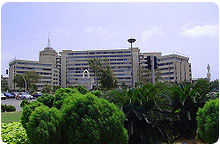 The
City of Karachi Municipal Act was promulgated in 1933. Initially the
Municipal Corporation comprised the mayor, the deputy mayor and 57
councillors. The Karachi Municipal Corporation was changed to a Metropolitan
Corporation in 1976. The administrative area of Karachi was a second-level
subdivision known as Karachi Division, which was subdivided into five
districts: Karachi Central, Karachi East, Karachi South, Karachi West and
Malir. In 2000, the national government implemented a new devolution plan
which abolished the second-tier divisions and merged the five districts of
Karachi into a new City District, structured as a three-tiered federation,
with the two lower tiers composed of 18 towns and 178 union councils (UC). The
City of Karachi Municipal Act was promulgated in 1933. Initially the
Municipal Corporation comprised the mayor, the deputy mayor and 57
councillors. The Karachi Municipal Corporation was changed to a Metropolitan
Corporation in 1976. The administrative area of Karachi was a second-level
subdivision known as Karachi Division, which was subdivided into five
districts: Karachi Central, Karachi East, Karachi South, Karachi West and
Malir. In 2000, the national government implemented a new devolution plan
which abolished the second-tier divisions and merged the five districts of
Karachi into a new City District, structured as a three-tiered federation,
with the two lower tiers composed of 18 towns and 178 union councils (UC).
The towns are governed by elected municipal administrations responsible for
infrastructure and spatial planning, development facilitation, and municipal
services (water, sanitation, solid waste, repairing roads, parks, street
lights, and traffic engineering), with some functions being retained by the
City-District Government (CDG). The third-tier 178 union councils are each
composed of thirteen directly elected members including a Nazim (mayor) and
a Naib Nazim (deputy mayor). The UC Nazim heads the union administration and
is responsible for facilitating the CDG to plan and execute municipal
services, as well as for informing higher authorities about public concerns
and complaints. Naimatullah Khan was the first Nazim of Karachi and
Shafiq-Ur-Rehman Paracha was the first DCO of Karachi, Paracha even served
as the last Commissioner of Karachi. Naimatullah Khan focused on building
new parks, providing entertainment outlets to the youth (to celebrate events
like Valentine's Day) and families (to celebrate events like Eid).
In the elections of 2005, Mustafa Kamal was elected City Nazim of Karachi to
succeed Naimatullah Khan, and Nasreen Jalil was elected as the City Naib
Nazim. Mustafa Kamal was previously the provincial minister for information
technology in Sindh. Mustafa Kamal is advancing the development trail and
has been actively involved in maintaining care of the city's municipal
systems
Go To Top
Economy
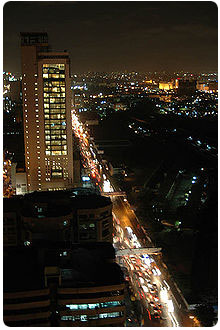 Karachi
is the financial and commercial capital of Pakistan. In line with its status
as a major port and the country's largest metropolis, it accounts for a
lion's share of Pakistan's revenue. According to the Federal Board of
Revenue's 2006-2007 year book, tax and customs units in Karachi were
responsible for 46.75% of direct taxes, 33.65% of federal excise tax, and
23.38% of domestic sales tax.Karachi accounts for 75.14% of customs duty and
79% of sales tax on imports.Therefore, Karachi collects a significant 53.38%
of the total collections of the Federal Board of Revenue (since renamed as
the Central Board of Revenue), out of which 53.33% are customs duty and
sales tax on imports.(Note: Revenue collected from Karachi includes revenue
from some other areas since the Large Tax Unit (LTU) Karachi and Regional
Tax Offices (RTOs) Karachi, Hyderabad, Sukkur & Quetta cover the entire
province of Sindh and Balochistan).Karachi's indigenous contribution to
national revenue is 25%.
Karachi's contribution to Pakistan's manufacturing sector amounts to
approximately 30 percent.A substantial chunk of Sindh’s gross domestic
product (GDP) is attributed to Karachi(the GDP of Sindh as a percentage of
Pakistan’s total GDP has traditionally hovered around 28%-30%).Karachi’s GDP
is around 20% of the total GDP of Pakistan. A PricewaterhouseCoopers study
released in 2009, which surveyed the 2008 GDP of the top cities in the
world, calculated Karachi’s GDP (PPP) to be $78 billion(projected to be $193
billion in 2025 at a growth rate of 5.5%).It confirmed Karachi’s status as
Pakistan’s largest economy, well ahead of the next two biggest cities Lahore
and Faisalabad, which had a reported GDP (PPP) in 2008 of $40 billion and
$14 billion, respectively.Karachi's high GDP is based on its mega-industrial
base, with a high dependency on the financial sector. Textiles, cement,
steel, heavy machinery, chemicals, food, banking and insurance are the major
segments contributing to Karachi's GDP. In February 2007, the World Bank
identified Karachi as the most business-friendly city in Pakistan.Karachi is
the nerve center of Pakistan's economy. The economic stagnation caused by
political anarchy, ethnic strife and resultant military operation during
late 80s and 90s led to efflux of industry from Karachi. Most of Pakistan's
public and private banks are headquartered on Karachi's I. I. Chundrigar
Road; according to a 2001 report, nearly 60% of the cashflow of the
Pakistani economy takes place on I. I. Chundrigar Road. Most major foreign
multinational corporations operating in Pakistan have their headquarters in
Karachi. The Karachi Stock Exchange is the largest stock exchange in
Pakistan, and is considered by many economists to be one of the prime
reasons for Pakistan's 8% GDP growth across 2005. A recent report by Credit
Suisse on Pakistan's stock market is a testimonial to its strong
fundamentals, estimating Pakistan’s relative return on equities at 26.7
percent, compared to Asia’s 11 percent. Karachi
is the financial and commercial capital of Pakistan. In line with its status
as a major port and the country's largest metropolis, it accounts for a
lion's share of Pakistan's revenue. According to the Federal Board of
Revenue's 2006-2007 year book, tax and customs units in Karachi were
responsible for 46.75% of direct taxes, 33.65% of federal excise tax, and
23.38% of domestic sales tax.Karachi accounts for 75.14% of customs duty and
79% of sales tax on imports.Therefore, Karachi collects a significant 53.38%
of the total collections of the Federal Board of Revenue (since renamed as
the Central Board of Revenue), out of which 53.33% are customs duty and
sales tax on imports.(Note: Revenue collected from Karachi includes revenue
from some other areas since the Large Tax Unit (LTU) Karachi and Regional
Tax Offices (RTOs) Karachi, Hyderabad, Sukkur & Quetta cover the entire
province of Sindh and Balochistan).Karachi's indigenous contribution to
national revenue is 25%.
Karachi's contribution to Pakistan's manufacturing sector amounts to
approximately 30 percent.A substantial chunk of Sindh’s gross domestic
product (GDP) is attributed to Karachi(the GDP of Sindh as a percentage of
Pakistan’s total GDP has traditionally hovered around 28%-30%).Karachi’s GDP
is around 20% of the total GDP of Pakistan. A PricewaterhouseCoopers study
released in 2009, which surveyed the 2008 GDP of the top cities in the
world, calculated Karachi’s GDP (PPP) to be $78 billion(projected to be $193
billion in 2025 at a growth rate of 5.5%).It confirmed Karachi’s status as
Pakistan’s largest economy, well ahead of the next two biggest cities Lahore
and Faisalabad, which had a reported GDP (PPP) in 2008 of $40 billion and
$14 billion, respectively.Karachi's high GDP is based on its mega-industrial
base, with a high dependency on the financial sector. Textiles, cement,
steel, heavy machinery, chemicals, food, banking and insurance are the major
segments contributing to Karachi's GDP. In February 2007, the World Bank
identified Karachi as the most business-friendly city in Pakistan.Karachi is
the nerve center of Pakistan's economy. The economic stagnation caused by
political anarchy, ethnic strife and resultant military operation during
late 80s and 90s led to efflux of industry from Karachi. Most of Pakistan's
public and private banks are headquartered on Karachi's I. I. Chundrigar
Road; according to a 2001 report, nearly 60% of the cashflow of the
Pakistani economy takes place on I. I. Chundrigar Road. Most major foreign
multinational corporations operating in Pakistan have their headquarters in
Karachi. The Karachi Stock Exchange is the largest stock exchange in
Pakistan, and is considered by many economists to be one of the prime
reasons for Pakistan's 8% GDP growth across 2005. A recent report by Credit
Suisse on Pakistan's stock market is a testimonial to its strong
fundamentals, estimating Pakistan’s relative return on equities at 26.7
percent, compared to Asia’s 11 percent.
Recently, Karachi has seen an expansion of information and communications
technology and electronic media and has become the software outsourcing hub
of Pakistan. Call centres for foreign companies have been targeted as a
significant area of growth, with the government making efforts to reduce
taxes by as much as 10% in order to gain foreign investments in the IT
sector. Many of Pakistan’s independent television and radio stations are
based in Karachi, including world-popular Business Plus, AAJ News, Geo TV,
KTN,Sindh TV,CNBC Pakistan, TV ONE, ARY Digital, Indus Television Network,
Samaa TV and Dawn News, as well as several local stations.
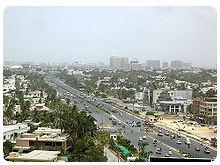 Karachi has several large industrial zones such as Karachi Export Processing
Zone, SITE, Korangi, Northern Bypass Industrial Zone, Bin Qasim and North
Karachi,
located on the fringes of the main city.Its primary areas of industry are
textiles, pharmaceuticals, steel, and automobiles. In addition, Karachi has
a vibrant cottage industry and there is a rapidly flourishing Free Zone with
an annual growth rate of nearly 6.5%. The Karachi Expo Centre hosts many
regional and international exhibitions.There are many development projects
proposed, approved and under construction in Karachi. Among projects of
note, Emaar Properties is proposing to invest $43bn (£22.8bn) in Karachi to
develop Bundal Island, which is a 12,000 acre (49 km²) island just off the
coast of Karachi.The Karachi Port Trust is planning a Rs. 20 billion, 1,947
feet (593 m) high Port Tower Complex on the Clifton shoreline.It will
comprise a hotel, a shopping center, an exhibition center and a revolving
restaurant with a viewing gallery offering a panoramic view of the coastline
and the city Karachi has several large industrial zones such as Karachi Export Processing
Zone, SITE, Korangi, Northern Bypass Industrial Zone, Bin Qasim and North
Karachi,
located on the fringes of the main city.Its primary areas of industry are
textiles, pharmaceuticals, steel, and automobiles. In addition, Karachi has
a vibrant cottage industry and there is a rapidly flourishing Free Zone with
an annual growth rate of nearly 6.5%. The Karachi Expo Centre hosts many
regional and international exhibitions.There are many development projects
proposed, approved and under construction in Karachi. Among projects of
note, Emaar Properties is proposing to invest $43bn (£22.8bn) in Karachi to
develop Bundal Island, which is a 12,000 acre (49 km²) island just off the
coast of Karachi.The Karachi Port Trust is planning a Rs. 20 billion, 1,947
feet (593 m) high Port Tower Complex on the Clifton shoreline.It will
comprise a hotel, a shopping center, an exhibition center and a revolving
restaurant with a viewing gallery offering a panoramic view of the coastline
and the city
Find more about
worldwide
Bussiness & Economy
Go To Top
Arts and Culture
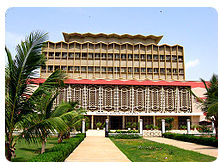 Karachi
is home to some of Pakistan's important cultural institutions. The National
Academy of Performing Arts,located in the newly renovated Hindu Gymkhana,
offers a two-year diploma course in performing arts that includes classical
music and contemporary theatre. The All Pakistan Music Conference, linked to
the 45-year-old similar institution in Lahore, has been holding its Annual
Music Festival since its inception in 2004. The Festival is now a
well-established feature of the city life of Karachi that is attended by
more than 3000 citizens of Karachi as well as people from other cities.The
National Arts Council (Koocha-e-Saqafat) has musical performances and
mushaira (poetry recitations). The Kara Film Festival annually showcases
independent Pakistani and international films and documentaries. Karachi
is home to some of Pakistan's important cultural institutions. The National
Academy of Performing Arts,located in the newly renovated Hindu Gymkhana,
offers a two-year diploma course in performing arts that includes classical
music and contemporary theatre. The All Pakistan Music Conference, linked to
the 45-year-old similar institution in Lahore, has been holding its Annual
Music Festival since its inception in 2004. The Festival is now a
well-established feature of the city life of Karachi that is attended by
more than 3000 citizens of Karachi as well as people from other cities.The
National Arts Council (Koocha-e-Saqafat) has musical performances and
mushaira (poetry recitations). The Kara Film Festival annually showcases
independent Pakistani and international films and documentaries.
Karachi has many museums that present exhibitions on a regular basis,
including the Mohatta Palace and the National Museum of Pakistan. Karachi
Expo Centre hosts many regional and international exhibitions.
The everyday lifestyle of Karachi differs substantially from that of other
Pakistani cities and towns. The culture of Karachi is characterized by the
blending of South Asian, Middle Eastern, Central Asian and Western
influences, as well as its status as a major international business centre.
After the partition of Indian subcontinent, Karachi received a large number
of refugees from all over India, whose influence is now evident in the
city's different sub-cultures. Karachi hosts the largest middle class
stratum of the country
Find more about
Culture of Pakistan ,
People, Art & Culture
Go To Top
Architecture
Karachi has a rich collection of buildings and structures of various
architectural styles and many modern style high rise buildings are under
construction. The downtown districts of Saddar and Clifton contain a rich
collection of early 20th century architecture, ranging in style from
neo-classical KPT building to the Sindh High Court Building. During the
British rule, Britishers wanted to model their Empire along the lines of
ancient Rome and classical architecture was considered most appropriate for
built monuments of the Raj.[citation needed] Karachi acquired its first
neo-Gothic or Indo-Gothic building when Frere Hall, Empress Market and St.
Patrick's Cathedral were completed. English Tudor style was introduced in
Karachi Gymkhana and the Boat Club. Italian Renaissance was very popular and
was the language for St. Joseph's Convent (1870) and the Sind Club
(1883).Classical style made a comeback in the late nineteenth century as
seen in Lady Dufferin Hospital (1898) and the Cantt. Railway Station. While
'Italianate' buildings remained popular, an eclectic blend termed Indo-Saracenic
or Anglo-Mughal began to emerge in some locations.
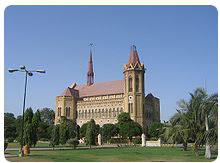 The
local mercantile community began acquiring impressive mercantile structures.
Zaibunnisa Street in Saddar area (known as Elphinstone Street in British
days) is an example where the mercantile groups adopted the 'Italianate' and
Indo-Saracenic style to demonstrate their familiarity with western culture
and their own. The Hindu Gymkhana (1925) and Mohatta Palace are the example
of Mughal revival buildings.The Sindh Wildlife Conservation Building,
located in Saddar, served as a Freemasonic Lodge until the time it was taken
over by the government. There are talks of it being taken away from this
custody and being renovated and the Lodge being preserved with its original
woodwork and ornate wooden staircase. The
local mercantile community began acquiring impressive mercantile structures.
Zaibunnisa Street in Saddar area (known as Elphinstone Street in British
days) is an example where the mercantile groups adopted the 'Italianate' and
Indo-Saracenic style to demonstrate their familiarity with western culture
and their own. The Hindu Gymkhana (1925) and Mohatta Palace are the example
of Mughal revival buildings.The Sindh Wildlife Conservation Building,
located in Saddar, served as a Freemasonic Lodge until the time it was taken
over by the government. There are talks of it being taken away from this
custody and being renovated and the Lodge being preserved with its original
woodwork and ornate wooden staircase.
In recent years, a large number of architecturally distinctive, even
eccentric, buildings have sprung up throughout Karachi. Notable examples of
contemporary architecture include the Pakistan State Oil Headquarters
building and the Karachi Financial Towers. The city has numerous examples of
modern Islamic architecture, including the Aga Khan University hospital,
Masjid e Tooba, Faran Mosque, Bait-ul Mukarram Mosque and Quaid's Mausoleum.
One of the unique cultural elements of Karachi is that the residences, which
are two- or three-story townhouses, are built with the front yard protected
by a high brick wall. Ibrahim Ismail Chundrigar Road displays a wide range
of supertall buildings. The most prominent examples include the Habib Bank
Plaza, PRC Towers and the MCB Tower which is the tallest skyscraper in
Pakistan.Perhaps one of the most spectacular buildings of modern times, Port
Tower Complex, a supertall skyscraper is proposed in the Clifton District of
the metropolis. At 593 metres, the building will comprise a hotel, a
shopping centre, an exhibition centre and a revolving restaurant with a
viewing gallery offering a panoramic view of the coastline and the city.
Many more high rise buildings are under construction, such as Centre Point
near Korangi Industrial Area, IT Tower, Sofitel Tower Karachi and Emerald
Tower. The Government of Sindh recently approved the construction of two
high-density zones, which will host the new city skyline
Go To Top
Fashion, Shopping and Entertainment
Karachi has always been proactive in organizing large events but because of
the political and economic crisis in the country, activities have recently
been slowed down. Karachi continues to host many different cultural and
fashion shows. In 2009 a four-day-long fashion show was organized in
Karachi's luxury Marriott hotel.Karachi has many glitzy shopping malls in
the Clifton area, Tariq Road, Gulshan-e-Iqbal and Hyderi shopping area, such
as Park Towers, The Forum, Dolmen Mall and Millenium Mall. Zamzama Boulevard
is known for its designer stores and many cafes. Almost all foreign brands
along with famous Pakistani fashion labels such as Amir Adnan, Aijazz,
Rizwan Beyg, Deepak Perwani, Shayanne Malik, Maria B, Khaadi, Sputnik
Footwear, Metro Shoes, English Boot House, Cotton & Cotton, Men's store and
Junaid Jamshed are present in various major shopping districts of the city
View Shopping Centers
Go To Top
Sports
View
Sports Centers
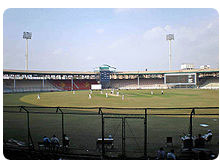 Cricket
is the most popular sport of the city and is usually played in many small
grounds around the city. Gully cricket is played in the narrow by-lanes of
the city. Nighttime cricket, popularly called 'night match', can be seen at
weekends when people play brightly lit, late night matches on less traversed
city streets and the game continues till dawn. Karachi has one world-class
cricket stadium, named National Stadium. The National Stadium (NSK), the
largest cricket stadium in Pakistan, became Karachi's fifth and Pakistan's
11th first-class ground. The inaugural first-class match was played at NSK
between Pakistan and India on April 21–24, 1955. In 34 Tests between that
first match and December 2000, Pakistan won 17 and were never beaten. Their
only Test defeat on the ground came in the gloom against England in 2000-01.
Since then, major terrorist activity, mainly bombings, have meant that
non-Asian sides have refused to play in the city, and in five years only
Bangladesh and Sri Lanka have visited. Cricket
is the most popular sport of the city and is usually played in many small
grounds around the city. Gully cricket is played in the narrow by-lanes of
the city. Nighttime cricket, popularly called 'night match', can be seen at
weekends when people play brightly lit, late night matches on less traversed
city streets and the game continues till dawn. Karachi has one world-class
cricket stadium, named National Stadium. The National Stadium (NSK), the
largest cricket stadium in Pakistan, became Karachi's fifth and Pakistan's
11th first-class ground. The inaugural first-class match was played at NSK
between Pakistan and India on April 21–24, 1955. In 34 Tests between that
first match and December 2000, Pakistan won 17 and were never beaten. Their
only Test defeat on the ground came in the gloom against England in 2000-01.
Since then, major terrorist activity, mainly bombings, have meant that
non-Asian sides have refused to play in the city, and in five years only
Bangladesh and Sri Lanka have visited.
The first One Day International at the National Stadium was against West
Indies on November 21, 1980, and it went down to the last ball as Gordon
Greenidge drove Imran Khan imperiously to the cover boundary with three
needed. It has been a far less successful limited-overs venue, with defeats
outnumbering victories. In fact, in a little under five years from the start
of 1996, Pakistan failed to win on the ground. It staged a quarter-final
match in the 1996-97 World Cup.
Other popular sports in the city are hockey, boxing, association football,
golf, table tennis, snooker, squash, and horse racing. Sports like
badminton, volleyball and basketball are popular in schools and colleges.
Football is especially popular in Lyari Town, which has a large Afro-Balochi
community and has always been a football-mad locality in Karachi. The
Peoples Football Stadium is perhaps the largest football stadium in Pakistan
with respect to capacity, easily accommodating around 40,000 people. In
2005, the city hosted the SAFF Championship at this ground, as well as the
Geo Super Football League 2007, which attracted capacity crowds during the
games.
The city has facilities for hockey (the Hockey Club of Pakistan, UBL Hockey
Ground), boxing (KPT Sports Complex), squash (Jahangir Khan Squash Complex)
and polo. Marinas and boating clubs add to the diverse sporting activities
in Karachi
Go To Top
Education
Satellite View of Educational Institutes
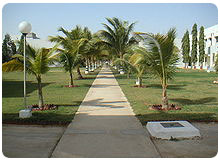 In
2008-09, the city's literacy rate was estimated at 65.26%,the highest in
Pakistan,with a gross enrolment ratio of 111%, the highest in Sindh. In
2008-09, the city's literacy rate was estimated at 65.26%,the highest in
Pakistan,with a gross enrolment ratio of 111%, the highest in Sindh.
Education in Karachi is divided into five levels: primary (grades one
through five); middle (grades six through eight); high (grades nine and ten,
leading to the Secondary School Certificate); intermediate (grades eleven
and twelve, leading to a Higher Secondary School Certificate); and
university programs leading to graduate and advanced degrees. Karachi has
both public and private educational institutions. Most educational
institutions are gender-based, from primary to university level.
Karachi Grammar School is the oldest school in Pakistan and has educated
many Pakistani businessmen and politicians. The Narayan Jagannath High
School in Karachi, which opened in 1855, was the first government school
established in Sindh. Other well-known schools include L'ecole for Advanced
Studies, the CAS School, Bay View High School, Bay View Academy, Karachi
American School, The Paradise School and College, Little Folks Secondary
School, Habib Public School, Mama Parsi Girls Secondary School, B.V.S. Parsi
Grammer School, Civilizations Public School, The Oasys School, Avicenna,
Lyceum, Ladybird Grammar School, The City School, Beaconhouse School System,
The Educators schools, Shahwilayat Public School, St Patrick's High School,
St Paul's English High School, St Joseph's Convent School, and St Michael's
Convent School.
The University of Karachi, known as KU, is Pakistan's largest university,
with a student population of 24,000 and one of the largest faculties in the
world. It is located next to the NED University of Engineering and
Technology, the country's oldest engineering institute. In the private
sector, Sir Syed University of Engineering and Technology (SSUET) provides
reputable training in biomedical engineering, civil engineering, electronics
engineering, telecom engineering and computer engineering. Dawood College of
Engineering and Technology offers degree programmes in electronic
engineering, chemical engineering, industrial engineering, materials
engineering and architecture. Karachi Institute of Economics & Technology (KIET)
has two campuses in Karachi and has been growing rapidly since its inception
in 1997. The Plastics Technology Center (PTC), located in Karachi's Korangi
Industrial Area, is at present Pakistan's only educational institution
providing training in the field of polymer engineering and plastics testing
services.The Institute of Business Administration (IBA), founded in 1955, is
the oldest business school outside of North America. The Shaheed Zulfiqar
Ali Bhutto Institute of Science and Technology (SZABIST), founded in 1995 by
Benazir Bhutto, is located in Karachi, with its other campuses in Islamabad,
Larkana and Dubai. Pakistan Navy Engineering College (PNEC) is a part of the
National University of Sciences and Technology (NUST), offering a wide range
of engineering programs, including electrical engineering and mechanical
engineering. Hamdard University is the largest private university in
Pakistan. Karachi is home of the head offices of the Institute of Chartered
Accountants of Pakistan (ICAP) (established in 1961) and the Institute of
Cost and Management Accountants of Pakistan (ICMAP). Among the many other
institutions providing business education are the College of Business
Management (CBM), SZABIST, Iqra University and the Institute of Business and
Technology (Biztek). Leading medical schools of Pakistan like The Aga Khan
University and Dow University of Health Sciences have their campuses in
Karachi. The National University of Computer and Emerging Sciences (NUCES-FAST),
one of Pakistan's top universities in computer education, operates two
campuses in Karachi. Bahria University also has a purpose-built campus in
Karachi.
For religious education, one of the largest Islamic education centers of
Asia, the Jamia Uloom ul Islamia, Banori Town, Karachi, is located in
Karachi
Find more about
Worldwide Education
Go To Top
Media
Media & News in Pakistan
Many of Pakistan’s independent television and radio channels are based in
Karachi, including Dawn News, Business Plus, Geo TV, CNBC Pakistan, Hum TV,
TV ONE, AAJ TV, ARY Digital, Express News, Indus Television Network, Kawish
Television Network (KTN), Good News TV, and Sindh TV as well as several
local stations. Local channels include Metro One.
Pakistan's premier news television networks are based in Karachi, including
News One, GEO News, ARY One World and AAJ News. AAG TV and MTV Pakistan are
the main music television channels and Business Plus and CNBC Pakistan are
the main business television channels based in the city. The bulk of
Pakistan's periodical publishing industry is centred in Karachi, including
magazines such as Spider, The Herald, Humsay, The Cricketer, Moorad Shipping
News, and The Internet.
Major advertising companies like Interflow Communications and Orient McCann
Erickson have their head offices in Karachi
Find more about
World Wide Media & News
Go To Top
Infrastructure
Transportation
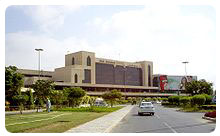 The
Jinnah International Airport is located in Karachi. It is the largest and
busiest airport of Pakistan. It handles 10 million passengers a year. The
airport receives the largest number of foreign airlines, a total of 35
airlines and cargo operators fly to Jinnah International predominantly from
the Middle East and Southeast Asia. All of Pakistan's airlines use Karachi
as their primary transport hub including PIA - Pakistan International
Airlines, Airblue, and Shaheen Air International. The
Jinnah International Airport is located in Karachi. It is the largest and
busiest airport of Pakistan. It handles 10 million passengers a year. The
airport receives the largest number of foreign airlines, a total of 35
airlines and cargo operators fly to Jinnah International predominantly from
the Middle East and Southeast Asia. All of Pakistan's airlines use Karachi
as their primary transport hub including PIA - Pakistan International
Airlines, Airblue, and Shaheen Air International.
The city's old airport terminals are now used for Hajj flights, offices,
cargo facilities, and ceremonial visits from heads of state. U.S. Coalition
forces used the old terminals for their logistic supply operations as well.
The city has two other airstrips, used primarily by the armed forces.
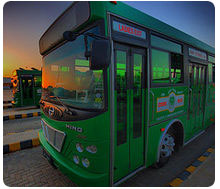 The
largest shipping ports in Pakistan are the Port of Karachi and the nearby
Port Qasim. These seaports have modern facilities and not only handle trade
for Pakistan, but serve as ports for Afghanistan and the landlocked Central
Asian countries. Plans have been announced for new passenger facilities at
the Port of Karachi. Karachi is linked by rail to the rest of the country by
Pakistan Railways. The Karachi City Station and Karachi Cantonment Railway
Station are the city's two major railway stations. The railway system
handles a large amount of freight to and from the Karachi port and provides
passenger services to people traveling up country. The
largest shipping ports in Pakistan are the Port of Karachi and the nearby
Port Qasim. These seaports have modern facilities and not only handle trade
for Pakistan, but serve as ports for Afghanistan and the landlocked Central
Asian countries. Plans have been announced for new passenger facilities at
the Port of Karachi. Karachi is linked by rail to the rest of the country by
Pakistan Railways. The Karachi City Station and Karachi Cantonment Railway
Station are the city's two major railway stations. The railway system
handles a large amount of freight to and from the Karachi port and provides
passenger services to people traveling up country.
A project to transform the existing, but non-operational, Karachi Circular
Railway into a modern mass transit system has recently been approved by the
government. The $1.6 billion project will be financed by the Japan Bank for
International Cooperation and will be completed by 2013. The city government
has introduced an initiative to alleviate the transport pains by introducing
new CNG buses.
Go To Top
Health
and Medicine
Satellite View Of Hospital
Karachi district is a centre of research in biomedicine. The city is home to
at least 30 public hospitals and more than 80 private hospitals, including
the Karachi Institute of Heart Diseases, Spencer Eye Hospital, Civil
Hospital, PNS Rahat , Abbasi Shaheed Hospital, Aga Khan University Hospital,
Holy Family Hospital and Liaquat National Hospital, as well as Jinnah
Postgraduate Medical Centre, Ziauddin Hospital, South City Hospital, Kidney
Centre, Institute of Child Health, Karachi Institute of Radiology and
Nuclear Medicine (KIRAN), Haji Rang Elahi Eye Hospital, Tabba Cardiac
Medical Center, Patel Hospital, Layton Benevolent Trust Eye Hospital, Lady
Dufferin Hospital, and National Medical Centre.
Go To Top
In Sindhi
Popular Culture
Karachi has been sung in many Sindhi songs, notably the folk songs sung in
Sindhi marriages, called Sehra (سهرا) and Ladda (لاڏا), such as:
آيلڙي مون ته سُئي وڃائي ڪراچيءَ جي شهر مان مون سُئي گھُرائي
sung by Zarina Baloch and
ڪراچيءَ جي شهر مان منڊيون جوڙايم سونا گل ڪراچيءَ جي موٽر ڀرجي آيا
Karachi is known for the legend of Morirro Mirbahar, whose bravery has been
praised and sung by Shah Abdul Latif Bhitai in his poetry. The legend has
been depicted in the Sindhi movie Ghatoo Ghar na Ayaa (Sindhi: گھاتُو گھر نه
آيا).
Karachi jaa ddeeha' aee' raatioo' (Sindhi: ڪراچيءَ جا ڏينهن ۽ راتيون,
English: Days and Nights of Karachi) is a novel written by Muhammad Bakhsh
Johar.
Find more about
Culture of Pakistan
Go To Top
Crime
Al-Qaeda has a history of using safe houses in Karachi. Ramzi Binalshibh, an
al-Qaeda operative described as a "key facilitator for the terrorist attacks
on September 11, 2001,"was captured after a gunfight in the city in 2002.
Mullah Abdul Ghani Baradar, described as the number two official of the
Afghan Taliban, was captured in a "joint" CIA-Pakistani intelligence
operation in Karachi in February 2010. Mullah Mohammad Younis, a former
Taliban shadow governor in Afghanistan,and Agha Jan Mohtasim, another
"Afghan Taliban leader,"were both arrested in the city in early 2010. The
Washington Times reported in November 2009 that Mullah Mohammed Omar, the
head of the Afghan Taliban, had recently moved to Karachi.Taliban fighters
are increasingly using the city to raise money and for vacation.Recent
Pakistani media reports even claim Osama bin Laden is hiding in Karachi
Go To Top
|